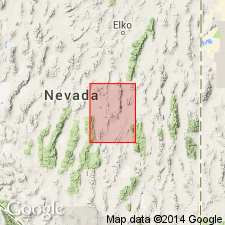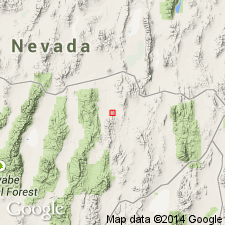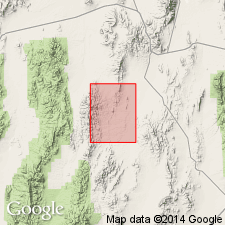
- Usage in publication:
-
- Bay State dolomite member*
- Modifications:
-
- Original reference
- Dominant lithology:
-
- Dolomite
- AAPG geologic province:
-
- Great Basin province
Summary:
Pg. 41, 45-46, pls. 1, 2. Bay State dolomite member of Nevada formation. Proposed for massive-bedded and dark-colored dolomites overlying Woodpecker limestone member (new) in vicinity of Eureka. Thickness 600 to 850 feet. Slight thickening to the north and west. Basal unit of member is a light-gray dolomite sand, that locally contains fragments of boulders of dolomite and siltstone, which forms a sharp contact with underlying Woodpecker limestone member. Contact with overlying Devils Gate limestone is gradational. Fossils (brachiopod STRINGOCEPHALUS). Age is Middle Devonian.
Type locality: section above Bay State Mine in Mining Canyon, [approx. Lat. 39 deg. 32 min. 08 sec. N., Long. 115 deg. 47 min. 46 sec. W., Diamond Peak 7.5-min quadrangle, White Pine Co., central NV]. Well exposed in vicinity of Bay State Mine on Newark Mountain.
Source: US geologic names lexicon (USGS Bull. 1200, p. 245); supplemental information from GNU records (USGS DDS-6; Menlo GNULEX).

- Usage in publication:
-
- Bay State dolomite member*
- Modifications:
-
- Age modified
- AAPG geologic province:
-
- Great Basin province
Summary:
Uppermost member of Nevada Formation is mapped on south side of Water Canyon and north to Homestead Canyon in central Diamond Mountains, Diamond Springs quad [White Pine Co] NV. Is principally heavy-bedded, dark-gray medium-crystalline dolomite with some light-gray beds. Is as thick as 850 ft. on southern side of Water Canyon. Contact with overlying Devils Gate Limestone is gradational. Overlies Sentinel Mountain Dolomite Member (Nevada Formation). Contains abundant CLADSPORA corals ("spaghetti rock") and STRINGOCEPHALUS brachiopods, indicating Middle Devonian age [although map explanation has "Early Devonian"].
Source: GNU records (USGS DDS-6; Menlo GNULEX).

- Usage in publication:
-
- Bay State Dolomite*
- Modifications:
-
- Revised
- AAPG geologic province:
-
- Great Basin province
Summary:
Raised to formation rank [the Nevada Formation is abandoned, its members being everywhere raised to formation rank].
Source: GNU records (USGS DDS-6; Menlo GNULEX).

- Usage in publication:
-
- Bay State Dolomite*
- Modifications:
-
- Mapped
- Dominant lithology:
-
- Dolomite
- AAPG geologic province:
-
- Great Basin province
Summary:
Mapped in Fish Creek Range in north part of Cockalorum Wash quad, Eureka Co, NV. Composed of medium to coarse-grained biostromal dolomite in resistant beds as much as 2 m thick. Includes some interbeds of micritic medium-gray limestone. Exposed thickness is more than 150 m. Bears similarity to parts of Fenstermaker Wash Formation in Antelope Range. Base not exposed. Grades up into Devils Gate Limestone. Assigned Middle Devonian age.
Source: GNU records (USGS DDS-6; Menlo GNULEX).
For more information, please contact Nancy Stamm, Geologic Names Committee Secretary.
Asterisk (*) indicates published by U.S. Geological Survey authors.
"No current usage" (†) implies that a name has been abandoned or has fallen into disuse. Former usage and, if known, replacement name given in parentheses ( ).
Slash (/) indicates name conflicts with nomenclatural guidelines (CSN, 1933; ACSN, 1961, 1970; NACSN, 1983, 2005, 2021). May be explained within brackets ([ ]).

